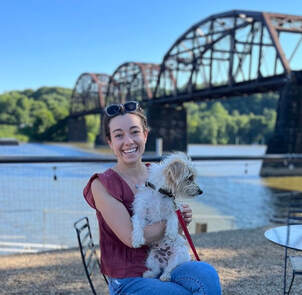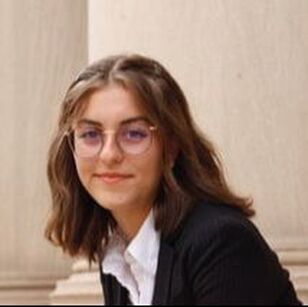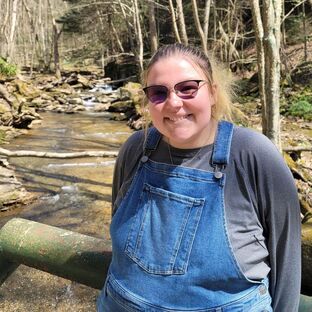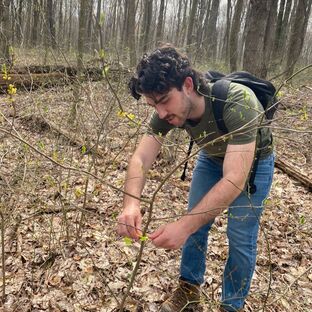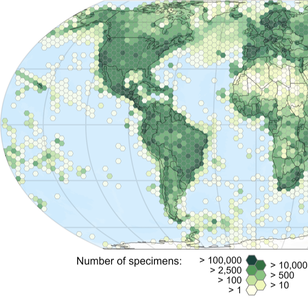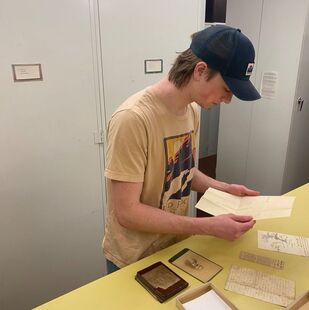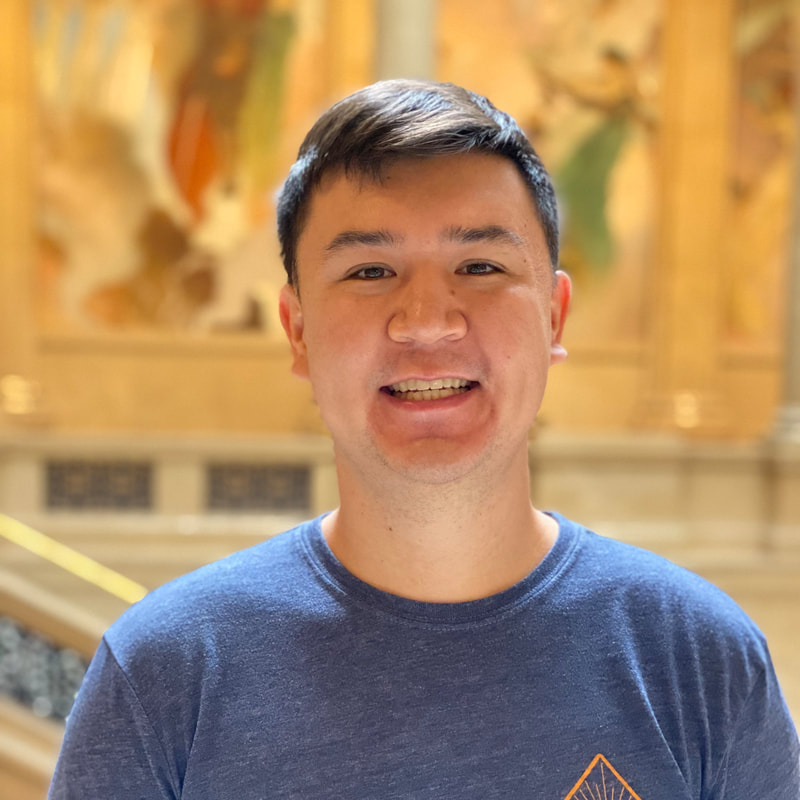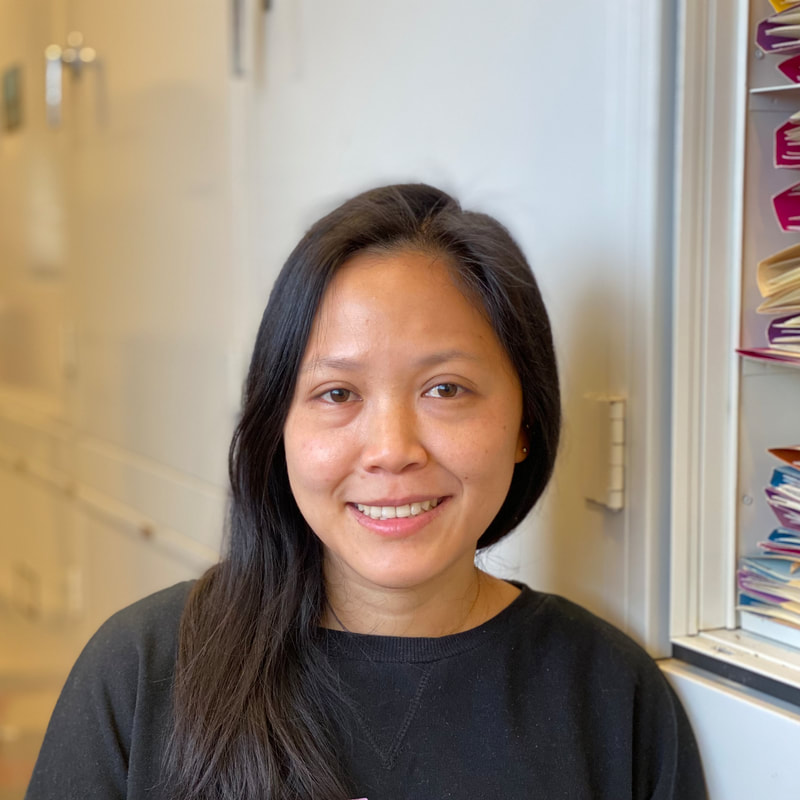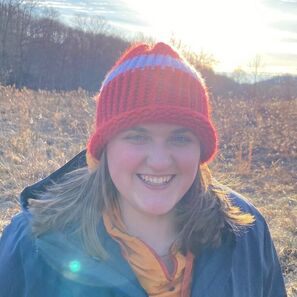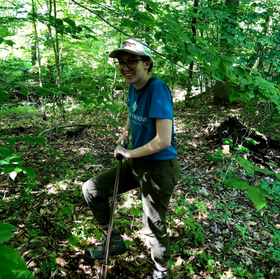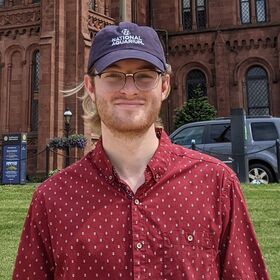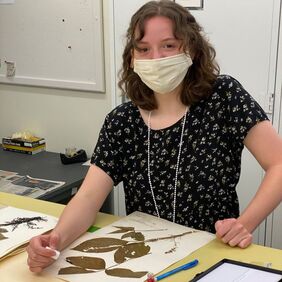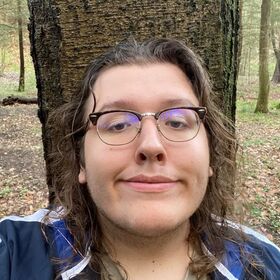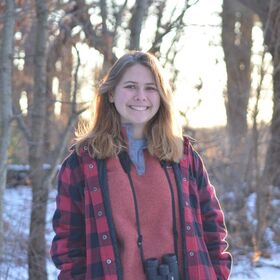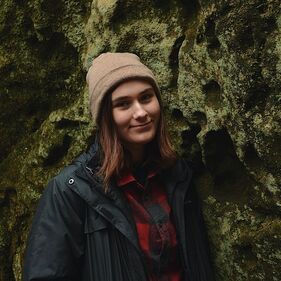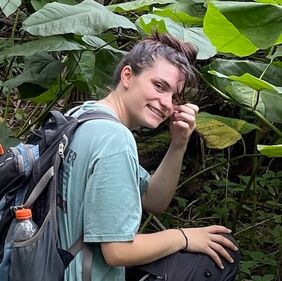For information on the Carnegie Museum of Natural History Section of Botany and Carnegie Museum herbarium (CM), including loans and visits, click HERE.
|
Mason Heberling, Associate Curator of Botany & Section Head
Section of Botany
Carnegie Museum of Natural History 4400 Forbes Avenue Pittsburgh, PA 15213 USA [email protected] Blog: collectedonthisday.com Adjunct Assistant Professor, Dept. of Biological Sciences, University of Pittsburgh
Adjunct Research Scientist, Hunt Institute for Botanical Documentation (Carnegie Mellon University) I am a botany curator and plant ecologist studying the functional ecology of understory plant species in temperate forests, especially in the context of climate change and introduced species invasions. As a museum curator, I strive to facilitate and broaden the use of natural history collections by students, researchers, and the public. As a museum-based researcher, I use herbarium specimens, field experiments, and observational data to understand basic plant function and complex ecological interactions. My research program explores a diverse range of topics under the umbrella of global change biology and museum collections.
|
Postdocs
|
Rachel Reeb, Postdoctoral Fellow in Botany
PhD 2023, University of Pittsburgh
Rachel is an ecologist who studies phenology and invasive species. Rachel has been a collaborator for several years and officially joined CMNH as a postdoc in August 2023. Rachel is leading a collaborative project at the museum on invasive plants, including the development of educational materials and a new exhibit.
|
Undergraduate students
|
Anna Cappella, Undergraduate Researcher
Carnegie Mellon University, Biological Sciences B.S.
Anna joined us in fall 2023 with a background in molecular biology and an enthusiasm to branch out and gain experience in botany and the plant sciences. Since then, she's joined our regular discussion research meetings and been volunteering in the herbarium preparing specimens.
|
|
Megan Gauger, Undergraduate Researcher & Field Technician
University of Pittsburgh, Environmental Science B.S.
2024 Joan K. Hunt and Rachel M. Hunt Summer Scholarship in Field Botany (Garden Club of America) 2023 Botanical Society of Western PA Undergraduate Research Award 2023 Earl Core Student Research Award (Southern Appalachian Botanical Society) 2023 Pennsylvania Native Plant Society Student Award 2023 Brackenridge Summer Fellowship (University of Pittsburgh) 2023 Torrey Botanical Society Undergraduate Research Award Megan joined the lab as a field technician on our Barking Slopes work in summer 2022 studying the effects of climate change and plant invasions on forest understory plants. Megan remains active in this project, regularly recording phenological observations in our plots. Megan also is active in a student led project investigating an understudied phenomenon of red leaf coloration in Trillium.
Starting in summer 2023, Megan began independent research monitoring the weather conditions that trigger floral movement (petals opening and closing depending on weather, time of day). Megan is also leading an important effort for a floristic inventory, including representative voucher herbarium specimens, for all vascular plants at our main field site, Barking Slopes Conservation Area. |
|
Chris Perrone, Undergraduate Researcher
University of Pittsburgh, Biological Sciences/Molecular Biology B.S. Program
2023 Botanical Society of Western PA Undergraduate Research Award 2023 Pennsylvania Native Plant Society Student Award 2023 Brackenridge Summer Fellowship (University of Pittsburgh) Chris joined the lab in late 2022 as a junior molecular biology major, craving plant ecology research experience. Chris is using herbarium specimens and fieldwork at Powdermill Nature Reserve to understand flowering time responses to climate and habitat difference between male and female plants of common spicebush (Lindera benzoin), a widespread shrub in Pennsylvania.
|
|
Rodrigo Monteagudo, Undergraduate Researcher
University of Pittsburgh, Urban Planning & Geographic Analysis B.S.
2023-2024 Pitt Honors College Research Hub Program Rodriguo joined the lab in fall 2023 as a part of a new "research hub" program connecting Pitt Honors College students with the Carnegie Museum for research experiences. Rodriguo is developing his skills in GIS and mapping to summarize and visualize the geographic, temporal, and taxonomic scope of the CM herbarium.
|
|
Jackson Wright, Undergraduate Researcher
University of Pittsburgh, Biological Sciences/Ecology & Evolution B.S. Program
Jackson joined the lab in fall 2023 and jumped right in on a history of botany project to understand a set of curious specimens at Carnegie Museum herbarium collected by Sergeant David C. Ralston during the Lady Franklin Bay Expedition (1881-1884) to the arctic during the First International Polar Year. He is researching how these specimens (and Ralston's diary) ended up at CM and whether other specimens from the expedition exist in other collections. The expedition is remember not only for reaching the Farthest North at the time but also a harrowing story in the history of arctic exploration. Of the 26 men who was on the expedition, all but six perished, including Ralston.
|
Alumni - Postdocs
|
Ben Lee, NSF Postdoctoral Fellow (2021-2023)
PhD 2020, University of Michigan
aBen is a forest ecologist, with special interest in the ecophysiological effects of climate change in the understory. He joined CMNH Botany in Fall 2021, funded through the NSF Postdoctoral Research Fellowships in Biology, Rules of Life program. His project used herbarium specimen roots and field sampling to understand changes in mycorrhizal communities across species' ranges and through time with global change. Ben continues also an active member of our NSF-funded phenological mismatch grant research, modeling long-term phenological responses of overstory and understory species across temperate North America, Europe, and East Asia using herbarium data.
Ben was co-sponsored by Dr. Sara Kuebbing at University of Pittsburgh (now at Yale University) and Dr. David Burke at Holden Forests & Gardens. |
|
Molly Ng, Rea Postdoctoral Fellow (2021-2023)
PhD 2020, University of Michigan
Molly is a botanist and paleobotanist, with special interest in linkages between leaf traits and climate. She applies these functional relationships in living and extant species to understand evolution in deep time. Molly joined CMNH in August 2021 as the museum's Rea Postdoctoral Fellow. Her project uniquely integrated specimens from the CM herbarium, the Paleobotany collection, and field sampling at Powdermill Nature Reserve, the museum's environmental research center.
Molly also collaborated with undergraduate student in the lab, Alyssa McCormick, on a project analyzing long term changes in poison ivy using herbarium specimens. |
Alumni - postbac students
|
Abby Yancy, Post-baccalaureate student (NSF REPS) (2021-2022)
BS 2021, University of Pittsburgh (Environmental Science)
2021-22, NSF-funded post-baccalaureate student 2022, Certified Local Phenology Leader, National Phenology Network Abby started at the museum as a part-time outdoor educator at Powdermill Nature Reserve, the museum's environmental research center. She was all set to join our undergraduate field crew in 2020, but that field work was disrupted by the COVID-19 pandemic. Abby joined CMNH Botany in spring 2021 as a field research assistant. She quickly became the point person for our phenological monitoring for our phenological mismatch projects. She is leading the charge on our outreach programs, including starting a new Nature's Notebook Local Phenology Program (community science project) at the museum's Powdermill Nature Reserve that invites the public to contribute phenological observations. She also led several independent research projects of her own, including testing the effects of leaf litter on forest herb phenology and a large scale biogeographic analysis of phenological strategies in the understory herb layer. Abby was funded through the NSF REPS program.
Since fall 2022, Abby is now a PhD student in the Department of Geology and Environmental Science at Pitt in Dr. Emily Elliott's lab, just across the street. She remains an active collaborator, including new work on the ecology and ecosystem impacts of invasive Reynoutria in the Pittsburgh region. |
Alumni - Former undergraduate students
|
Searrah Bierker, Undergraduate Researcher (2021-23)
B.S. 2023, Sustainability Program, Chatham University
2022 Undergraduate Research Award, Society of Herbarium Curators Searrah is studying the impacts of climate change on the flowering times of forest wildflowers of western Pennsylvania using herbarium specimens and impacts of CO2 change on fern stomata. She started in CMNH Botany in Fall 2021 for her internship digitizing specimens, and was involved in many projects along the way.
Searrah was awarded a 2022 undergraduate research award from the Society of Herbarium Curators to help fund her work piloting new methods of herbarium specimen collecting. |
|
Edith Fields, Undergraduate Researcher (2022)
BS 2022, Biological Sciences, University of Pittsburgh
Edie joined our team as a field assistant in summer 2022 working on our Barking Slopes field experiments, studying the effects of climate change and plant invasions on forest wildflowers. Edith was also active in a student led natural history project on the curious case of red leaf coloration in Trillium.
After CMNH, Edie worked with the Virginia state conservation corps in conservation and resource management. |
|
Jack Hatajik, Undergraduate Researcher (2021-23)
B.S. 2023, Biological Sciences, University of Pittsburgh
2022 Botanical Society of Western PA Undergraduate Research Award 2022 Brackenridge Summer Fellowship (University of Pittsburgh) 2023 Torrey Botanical Society Undergraduate Research Award Working closely with postdoc Dr. Ben Lee, Jack led a project studying population dynamics of the invasive species Alliaria petiolata. He used a variety of methods ranging from herbarium specimens to climate modeling. Jack was also involved in our wildflower research, helping with photosynthetic measurements in the field to understand the impact of altered shading regimes on native wildflowers.
After CMNH, Jack began a master's program in the Forest School at Yale University. |
|
Alyssa McCormick, Undergraduate Researcher (2021-22)
B.S. 2022, Sustainability Program, Chatham University
Alyssa studied the impacts of climate change on poison ivy using herbarium specimens. She started in CMNH Botany as a research internship (summer 2021) and her research remained active in the herbarium through the following school year. Her research was presented at the 2021 PA Botany Symposium and is featured in an exhibit in the museum's Hall of Botany.
Alyssa was co-mentored by Dr. Ryan Utz in the Falk School of Sustainability & Environment at Chatham University.
Her project was published in American Journal of Botany! [read it here] |
|
John Mamas, Undergraduate Researcher (2022-23)
B.S. 2023, Environmental Science, Chatham University
John studied a set of unique specimens at the CM herbarium collected by Michel Adanson from the 1750s to 1790s. Though Adanson's main collection and majority of his remaining specimens are at Muséum National d'Histoire Naturelle (P), these historic specimens ended up in Pittsburgh. These specimens each have something "odd" or unusual about them, specifically noted by Adanson, which he called Monstruosités." John studied the provenance of these specimens and their significance to the history of botany.
|
|
Ellen Oordt, Undergraduate Researcher (2021-22)
BS 2022, Biological Sciences, University of Pittsburgh
Ellen was a member of the Kuebbing Lab at the University of Pittsburgh. Though we've known her for much longer, she officially joined CMNH Botany in spring semester 2022 and continued through early summer 2022 as a field research assistant on our phenology fieldwork.
After CMNH, Ellen moved on to a research internship at Longwood Gardens.
|
|
Meri Raughley, Undergraduate Researcher (2021)
BS 2022, Biological Sciences, University of Pittsburgh
Koa was a member of the Kuebbing Lab at the University of Pittsburgh and joined CMNH Botany in 2021 as a summer field research assistant on our phenology fieldwork. She continued in the museum using herbarium specimens to study phenological change across time and geography in an invasive plant, Chorispora tenella.
After CMNH, Meri moved to Alaska as a Conservation Intern with the US Forest Service.
|
|
Koa Reitz, Undergraduate Researcher (2021)
BS 2022, Biological Sciences, University of Pittsburgh
Koa was a member of the Kuebbing Lab at the University of Pittsburgh and officially joined CMNH Botany in 2021 as a summer field research assistant on our phenology fieldwork. She continued in the museum using herbarium specimens to study phenological change across time and geography in an invasive plant, Chorispora tenella.
After CMNH, Koa moved to a position at the Great Smoky Mountains National Park to study the impacts of Balsam Woolly Adelgid.
|
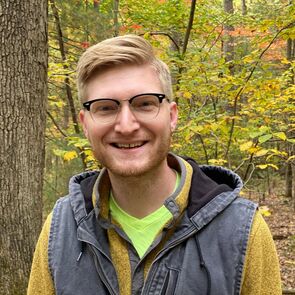

 orcid.org/0000-0003-0756-5090
orcid.org/0000-0003-0756-5090